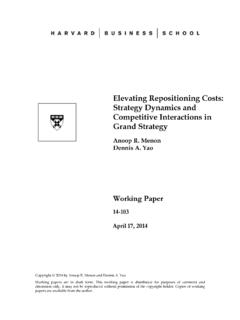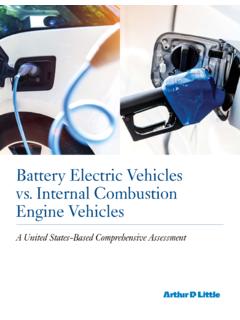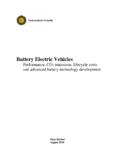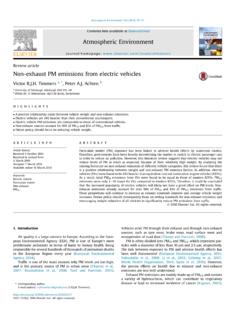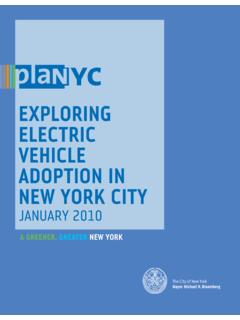Transcription of Sustainable eet operations: The collaborative …
1 Sustainable fleet operations : The collaborative adoption of electric vehicles Vanessa Chocteau David Drake , Paul R. Kleindorfer Renato J. Orsato Alain Roset . * La Poste, 111 Boulevard Brune, 75014 Paris, France ** INSEAD, Boulevard de Constance, 77305 Fontainebleau, France ** FGV/EAESP, Rua Itapeva 474-80 andar, 01332-000 Bela Vista, S ao Paulo, Brazil Corresponding Author: We study the impact of collaboration on the adoption of electric vehicles (EVs) among commercial fleets. Using cooperative game theory, we characterize the joint payoffs for the primary stakeholders in the EV. adoption decision the fleet manager, auto manufacturer, and electricity supplier to determine the con- ditions under which EVs become economically feasible for commercial fleets.
2 We do so in two settings. We first analyze a scenario where all three stakeholders cooperate in the EV adoption decision, a setting per- tinent in regions such as France where a national electricity supplier makes such an arrangement feasible. We next analyze a scenario where the fleet manager and auto manufacturer cooperate but the electricity supplier participates as an independent actor, a setting pertinent in regions such as the United States where no single electricity supplier possesses sufficient market scope to become involved in the EV decision on a national scale. We show that convex per unit EV production costs drive a boundary solution for both the two- and three-party coalition EV adoption decision.
3 We also illustrate the impact of carbon and operating cost advantages of EVs relative to internal combustion vehicles on the adoption of EVs and complementary vehicle -to-grid technology. Comparing the regions of EV adoption within the two coalition settings provides insights into the value of the electricity supplier's cooperation and the conditions under which intermediation to promote such cooperation can add value. April 2011. Key words : Fleet management; Carbon regulation; Sustainable operations ; Collaboration 1. Introduction Ground transportation generates approximately 23% of global carbon dioxide equivalent (CO2e). emissions (International Energy Agency 2009), and electric vehicles (EVs) represent one of the most promising avenues to reduce this impact.
4 EVs can eliminate up to 100% of internal combustion vehicle (ICE) emissions, depending on the technology employed to produce the electricity needed to recharge EV batteries. While current EV performance limitations make them infeasible for some applications such as long-haul operations , they are well-suited for fleets specializing in last mile . delivery services such as postal operators and short-haul commercial service providers ( , DHL, FedEx, TNT, UPS, etc.). 1. Chocteau, et al.: collaborative adoption of electric vehicles 2. Most of the existing literature on fleet management, including the EV adoption decision, focuses on a given fleet manager's internal cost drivers, based on the implicit presumption that prices and technology choices will be mediated by the market.
5 In the case of EVs and other infant . technologies being considered as part of Sustainable transportation, the principal challenge in eval- uating fleet replacement choices goes beyond these (still important) internal drivers. In many cases, cooperation among external stakeholders is necessary to trigger initiating investments in the new technologies, so one must also understand the hurdles and opportunities of these potential partners. This cooperation among independent stakeholders and the conditions leading to EV adoption are the central problem we address in this paper. We consider the decision of a fleet manager who faces the requirement to replace a fixed stock of vehicles with some combination of EVs and ICEs, while also considering the decision of the auto manufacturer on whether to produce and how to price EVs, and by the electricity supplier on whether to connect EVs to the grid through vehicle -to-grid (V2G) technology.
6 In line with standard fleet practice we assume that vehicles will be leased for a finite period and then resold into the used vehicle market. The evaluation of EV versus ICE traction systems is of interest to several stakeholders including fleet mangers, auto manufacturers, and electricity suppliers. In addition to potential reputation ben- efits resulting from reduced environmental impacts, EVs also offer fleet managers more measurable benefits relative to ICEs. EVs provide fleet managers an estimated 50% reduction in maintenance costs due to their simpler drive train (USPS-OIG 2009), and reduced operating costs due to lower estimated per mile electricity costs versus per mile gasoline costs.
7 From the perspective of established auto manufacturers, EVs are emerging as a new competitive frontier due to their envi- ronmental benefits. Large auto manufacturers are further motivated to enter the EV market by the threat from new entrants specializing in EV drive-train technologies. Finally, the electricity supplier gains incremental (and typically off-peak) demand through the adoption of EVs, as well as energy storage for frequency regulation and contingent load management through V2G operations . Despite the advantages that EVs can offer, the technology suffers from a classic catch-22: main- stream EV adoption among profit-maximizing commercial fleets requires the technology to be economically preferred to ICEs; however, for EVs to be economically preferred, the auto manufac- turer must see mainstream volumes in order to achieve the necessary learning and scale economies.
8 In such a setting, mainstream EV adoption is unlikely without collaboration. To understand the impact of such collaboration, and the conditions under which EVs could become an economically feasible solution for commercial fleet vehicle replacement, we characterize the joint payoffs for the parties described above using cooperative game theory. We focus on a cooperative game incorporating three basic elements of the EV decision: produc- tion and sales of EVs by the auto manufacturer, their operation by the fleet manager and their Chocteau, et al.: collaborative adoption of electric vehicles 3. interconnection with the electricity supplier for recharging and V2G services. We first consider a setting where the fleet manager, auto manufacturer and electricity supplier partner in evaluating the feasibility of electric vehicles.
9 Such a setting is pertinent in countries such as France, where . La Poste (the national postal operator), Renault (a major auto manufacturer), and Electricit . e de France (EDF, the national electricity service provider) are currently evaluating the EV opportu- nity. We then consider a partnership between the fleet manager and auto manufacturer, with the electricity supplier acting independently , the electricity supplier can benefit from EV adoption by investing in V2G services, but it is not directly involved in the adoption decision. This scenario represents settings such as in the United States where no single electricity supplier possesses the market scope to become involved in the EV decision on a national scale.
10 We show that the convexity of EV production costs leads to an all-or-nothing boundary solution for EV adoption . Similarly, a comparison of V2G infrastructure costs to grid efficiency gains leads to boundary solutions for V2G adoption . This results in three regions of adoption in both the two- and three-party coalition settings: zero adoption of EVs and V2G services, full adoption of EVs with no adoption of V2G services, and full adoption of both technologies. Contrasting the regions of adoption for the two- and three-party coalition scenarios provides insights on the value of the electricity supplier's cooperation. Such a contrast also provides insights on the conditions under which an outside player can influence the adoption of EVs by the primary stakeholders.



